Influences of Tidal Effect on Upper Ocean Responses to Typhoon Passages Surrounding Shore Region off Northeast Taiwan
Abstract
:1. Introduction
2. Data and Methods
2.1. Typhoons
2.2. Moored Buoy Data
2.3. Ocean Model Description and Experiment Design
3. Validations
4. Tidal Effect on Typhoon-Induced Cold Wakes with vs. without Tide
5. Potential Mechanisms of How Tide Enhances Cold Wakes
5.1. Stronger Current Leads to Sharper Bottom Thermocline
5.2. Stronger Bottom Stress, Ekman Flow Leads to Destratification of Bottom Water Column
5.3. Residual Terms
5.4. Wind–Tide Coupled Effect
6. Conclusions and Remarks
Supplementary Materials
Author Contributions
Funding
Data Availability Statement
Conflicts of Interest
References
- Cione, J.; Uhlhorn, E. Sea surface temperature variability in hurricanes: Implications with respect to intensity change. Mon. Weather Rev. 2003, 131, 1783–1796. [Google Scholar] [CrossRef] [Green Version]
- Lin, I.-I.; Liu, W.T.; Wu, C.-C.; Wong, G.T.F.; Hu, C.; Chen, Z.; Liang, W.-D.; Yang, Y.; Liu, K.-K. New evidence for enhanced ocean primary production triggered by tropical cyclone. Geophys. Res. Lett. 2003, 30, 1718. [Google Scholar] [CrossRef] [Green Version]
- Babin, S.M.; Carton, J.A.; Dickey, T.D.; Wiggert, J.D. Satellite evidence of hurricane-induced phytoplankton blooms in an oceanic desert. J. Geophys. Res. Oceans 2004, 109, C03043. [Google Scholar] [CrossRef] [Green Version]
- Siswanto, E.; Ishizaka, J.; Yokouchi, K.; Tanaka, K.; Tan, C.K. Estimation of interannual and interdecadal variations of typhoon-induced primary production: A case study for the outer shelf of the East China Sea. Geophys. Res. Lett. 2007, 34, L03604. [Google Scholar] [CrossRef]
- Morimoto, A.; Kojima, S.; Jan, S.; Takahashi, D. Movement of the Kuroshio axis to the northeast shelf of Taiwan during typhoon events. Estuar. Coast. Shelf Sci. 2009, 82, 547–552. [Google Scholar] [CrossRef]
- Zheng, Z.-W.; Ho, C.-R.; Zheng, Q.; Lo, Y.-T.; Kuo, N.-J.; Gopalakrishnan, G. Effects of preexisting cyclonic eddies on upper ocean responses to Category 5 typhoons in the western North Pacific. J. Geophys. Res. Oceans 2010, 115, C09013. [Google Scholar] [CrossRef]
- Zheng, Z.-W.; Lin, I.-I.; Wang, B.; Huang, H.-C.; Chen, C.-H. A long neglected damper in the El Nino-typhoon relationship: A Gaia-like process. Sci. Rep. 2015, 5, 11103. [Google Scholar] [CrossRef] [Green Version]
- Kuo, Y.-C.; Zheng, Z.-W.; Zheng, Q.; Gopalakrishnan, G.; Lee, C.-Y.; Chern, S.-W.; Chao, Y.-H. Typhoon induced summer cold shock advected by Kuroshio off eastern Taiwan. Ocean Model. 2017, 109, 1–10. [Google Scholar] [CrossRef]
- Mohanty, S.; Nadimpalli, R.; Osuri, K.K.; Pattanayak, S.; Mohanty, U.C.; Sil, S. Role of sea surface temperature in modulating life cycle of tropical cyclones over bay of Bengal. Trop. Cyclone Res. Rev. 2019, 8, 68–83. [Google Scholar] [CrossRef]
- Schade, L.R.; Emanuel, K.A. The ocean’s effect on the intensity of tropical cyclones: Results from a simple coupled atmosphere ocean model. J. Atmos. Sci. 1999, 56, 642–651. [Google Scholar] [CrossRef]
- Shay, L.K.; Goni, G.J.; Black, P.G. Effects of a warm oceanic feature on Hurricane Opal. Mon. Weather Rev. 2000, 128, 1366–1383. [Google Scholar] [CrossRef]
- Wu, C.-C.; Lee, C.-Y.; Lin, I.-I. The effect of the ocean eddy on tropical cyclone intensity. J. Atmos. Sci. 2007, 64, 3562–3578. [Google Scholar] [CrossRef]
- Lin, I.-I.; Wu, C.-C.; Pun, I.-F.; Ko, D.-S. Upper-ocean thermal structure and the western North Pacific category 5 typhoons. Part I: Ocean features and the category 5 typhoons’ intensification. Mon. Weather Rev. 2008, 136, 3288–3306. [Google Scholar] [CrossRef] [Green Version]
- Lee, C.-Y.; Chen, S.S. Stable boundary layer and its impact on tropical cyclone structure in a coupled atmosphere-ocean model. Mon. Wea. Rev. 2014, 142, 1927–1944. [Google Scholar] [CrossRef]
- Glenn, S.M.; Miles, T.N.; Seroka, G.N.; Xu, Y.; Forney, R.K.; Yu, F.; Roarty, H.; Schofield, O.; Kohut, J. Stratified coastal ocean interactions with tropical cyclones. Nat. Commun. 2016, 7, 10887. [Google Scholar] [CrossRef] [Green Version]
- Kuo, Y.-C.; Zheng, Z.-W.; Zheng, Q.; Gopalakrishnan, G.; Lee, H.-Y. Typhoon-Kuroshio interaction in an air-sea coupled system: Case study of typhoon Nanmadol (2011). Ocean Model. 2018, 132, 130–138. [Google Scholar] [CrossRef]
- Mitchell, D.A.; Teague, W.J.; Jarosz, E.; Wang, W. Observed currents over the outer continental shelf during Hurricane Ivan. Geophys. Res. Lett. 2005, 32, L11610. [Google Scholar] [CrossRef] [Green Version]
- Teague, W.J.; Jarosz, E.; Wang, D.W.; Mitchell, D.A. Observed oceanic response over the upper continental slope and outer shelf during Hurricane Ivan. J. Phys. Oceanogr. 2007, 37, 2181–2206. [Google Scholar] [CrossRef] [Green Version]
- Zhang, Z.; Wang, Y.; Zhang, W.; Xu, J. Coastal ocean response and its feedback to Typhoon Hato (2017) over the South China Sea: A numerical study. J. Geophys. Res. Atmos. 2019, 124, 13731–13749. [Google Scholar] [CrossRef]
- Cheriton, O.M.; Storlazzi, C.D.; Rosenberger, K.J.; Sherman, C.E.; Schmidt, W.E. Rapid observations of ocean dynamics and stratification along a steep island coast during Hurricane María. Sci. Adv. 2021, 7, eabf1552. [Google Scholar] [CrossRef]
- Ko, D.S.; Chao, S.Y.; Wu, C.C.; Lin, I.I.; Jan, S. Impacts of tides and Typhoon Fanapi (2010) on seas around Taiwan. Terr. Atmos. Ocean. Sci. 2016, 27, 261–280. [Google Scholar] [CrossRef] [Green Version]
- Lima, M.M.; Gouveia, C.M.; Trigo, R.M. Upper Ocean Response on the Passage of Tropical Cyclones in the Azores Region. EGUsphere 2022. [Preprint]. [Google Scholar] [CrossRef]
- Souza, A.J.; Simpson, J.H. The modification of tidal ellipses by stratification in the Rhine ROFI. Cont. Shelf Res. 1996, 18, 997–1007. [Google Scholar] [CrossRef] [Green Version]
- Bravo, L.; Ramos, M.; Sobarzo, M.; Pizarro, O.; Valle-Levinson, A. Barotropic and baroclinic semidiurnal tidal currents in two contrasting coastal upwelling zones of Chile. J. Geophys. Res. Ocean. 2013, 118, 1226–1238. [Google Scholar] [CrossRef]
- Mandal, S.; Sil, S.; Gangopadhyay, A. Tide-current-eddy interaction: A seasonal study using high frequency radar observations along the western Bay of Bengal near 16° N. Estuar. Coast. Shelf Sci. 2020, 232, 106523. [Google Scholar] [CrossRef]
- Matthews, J.B.R. Comparing historical and modern methods of sea surface temperature measurement-part 1: Review of methods, field comparisons and dataset adjustments. Ocean Sci. 2013, 9, 683–694. [Google Scholar] [CrossRef] [Green Version]
- Doong, D.-J.; Peng, J.P.; Babanin, A.V. Field investigations of coastal sea surface temperature drop after typhoon passages. Earth Syst. Sci. Data 2019, 11, 323–340. [Google Scholar] [CrossRef] [Green Version]
- Large, W.G.; McWilliams, J.C.; Doney, S.C. Oceanic vertical mixing: A review and a model with a nonlocal boundary layer parameterization. Rev. Geophys. 1994, 32, 363–403. [Google Scholar] [CrossRef] [Green Version]
- Song, Y.; Haidvogel, D.B. A semi-implicit ocean circulation model using a generalized topography-following coordinate system. J. Comput. Phys. 1994, 115, 228–244. [Google Scholar] [CrossRef]
- Cummings, J.A. Operational multivariate ocean data assimilation, Q.J.R. Meteorol. Soc. 2005, 131, 3583–3604. [Google Scholar] [CrossRef]
- Shchepetkin, A.F.; McWilliams, J.C. Method for computing horizontal pressure-gradient force in an oceanic model with a nonaligned vertical coordinate. J. Geophys. Res. 2003, 108, 3090. [Google Scholar] [CrossRef] [Green Version]
- Shchepetkin, A.F.; McWilliams, J.C. The regional oceanic modeling system (ROMS): A split-explicit, free-surface, topography-following-coordinate oceanic model. Ocean Modell. 2005, 9, 347–404. [Google Scholar] [CrossRef]
- Zheng, Z.-W.; Zheng, Q.; Lee, C.-Y.; Gopalakrishnan, G. Transient modulation of Kuroshio upper layer flow by directly impinging typhoon Morakot in east of Taiwan in 2009. J. Geophys. Res. Oceans 2014, 119, 4462–4473. [Google Scholar] [CrossRef]
- Shen, D.; Li, X.; Wang, J.; Bao, S.; Pietrafesa, L.J. Dynamical ocean responses to Typhoon Malakas (2016) in the vicinity of Taiwan. J. Geophys. Res. Oceans 2021, 126, e2020JC016663. [Google Scholar] [CrossRef]
- Flather, R.A. A tidal model of the northwest European continental shelf. Mem. Soc. Roy. Sci. Liege 1976, 10, 141–164. [Google Scholar]
- Lai, Y.-H.; Lu, C.-Y.; Zheng, Z.-W.; Chiang, L.-C.; Ho, C.-R. Numerical Simulation of the Trajectory of Garbage Falling into the Sea at the Coastal Landfill in Northeast Taiwan. Water 2022, 14, 1251. [Google Scholar] [CrossRef]
- Egbert, G.; Erofeeva, S. Efficient inverse modeling of barotropic ocean tides. J. Atmos. Ocean. Technol. 2002, 19, 183–204. [Google Scholar] [CrossRef]
- Tomczak, M.; Godfrey, J.S. Regional Oceanography: An Introduction; Elsevier: Amsterdam, The Netherlands, 1994. [Google Scholar]
- Webb, D.J.; Holmes, R.M.; Spence, P.; England, M.H. Barotropic Kelvin wave-induced bottom boundary layer warming along the West Antarctic Peninsula. J. Geophys. Res. Oceans 2019, 124, 1595–1615. [Google Scholar] [CrossRef]
- Chen, K.Y.; Huang, C.F.; Huang, S.W.; Liu, J.Y.; Guo, J. Mapping coastal circulations using moving vehicle acoustic tomography. J. Acoust. Soc. Am. 2020, 148, EL353–EL358. [Google Scholar] [CrossRef] [PubMed]
- Price, J.F. Upper ocean response to a hurricane. J. Phys. Oceanogr. 1981, 11, 153–175. [Google Scholar] [CrossRef]
- Zambon, J.B.; He, R.; Warner, J.C. Investigation of hurricane Ivan using the coupled ocean–atmosphere–wave–sediment transport (COAWST) model. Ocean Dyn. 2014, 64, 1535–1554. [Google Scholar] [CrossRef]
- Zhang, S.; Xie, L.; Hou, Y.; Zhao, H.; Qi, Y.; Yi, X. Tropical storm-induced turbulent mixing and chlorophyll-a enhancement in the continental shelf southeast of Hainan Island. J. Mar. Syst. 2014, 129, 205–414. [Google Scholar] [CrossRef]
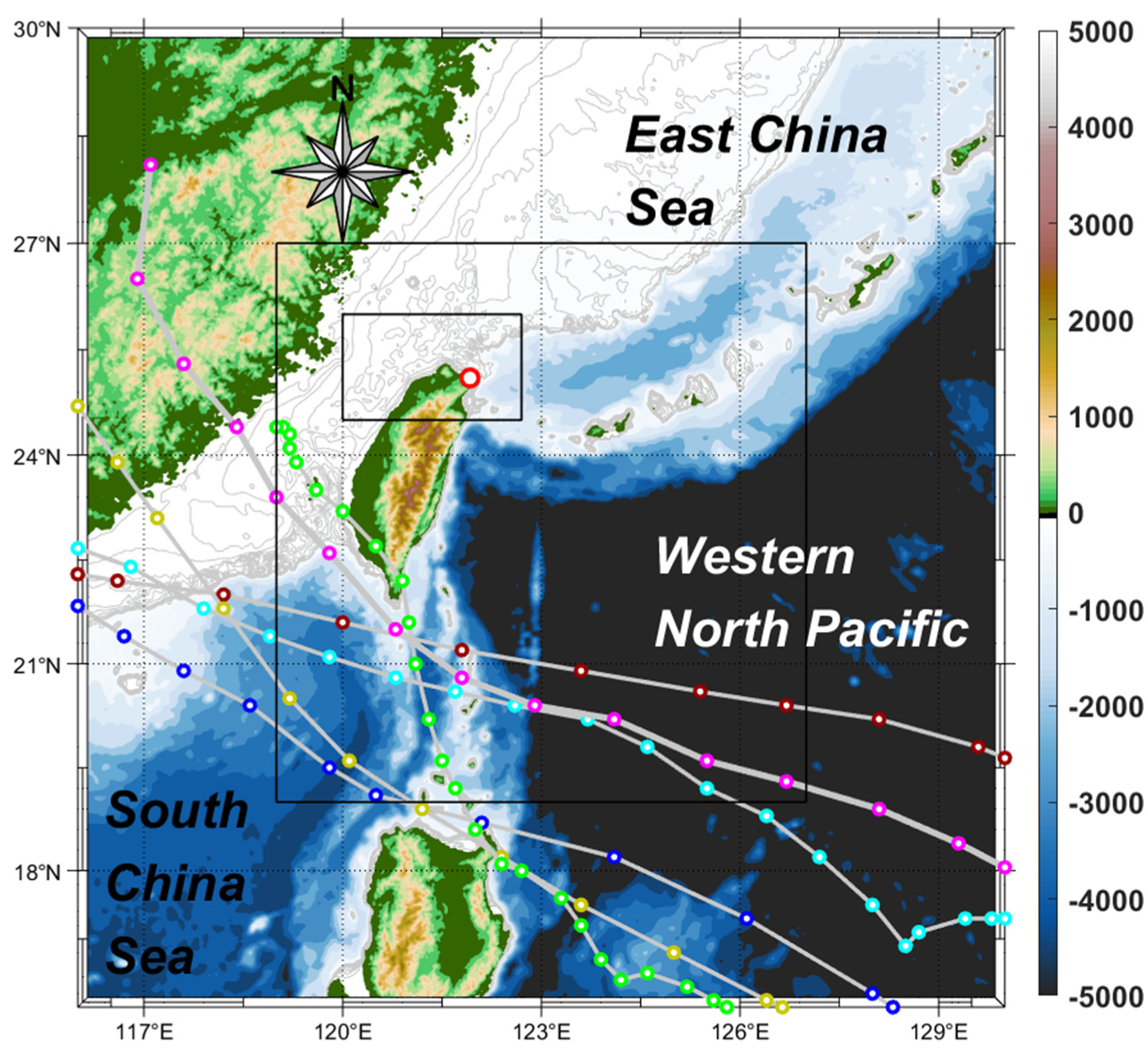
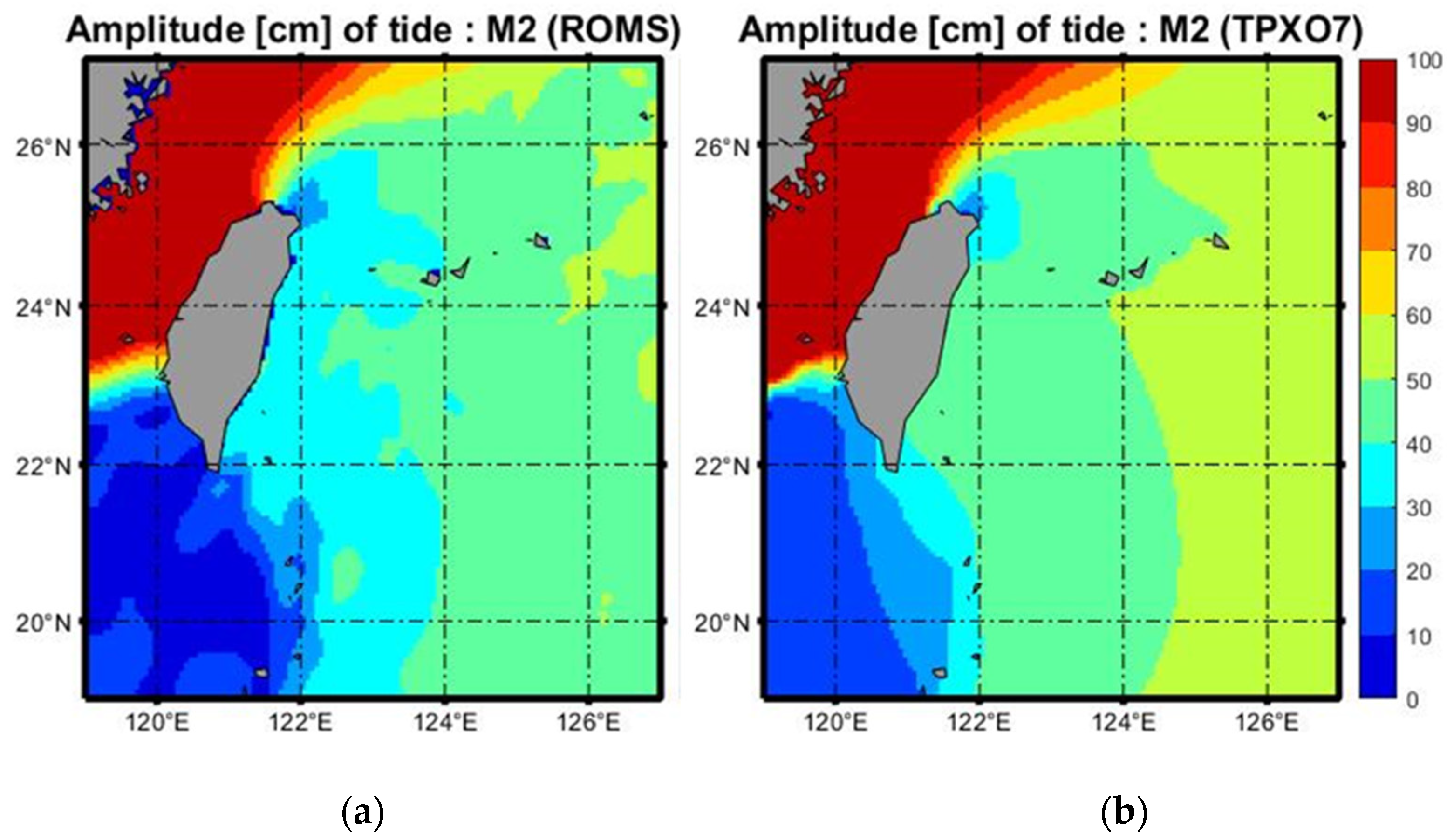
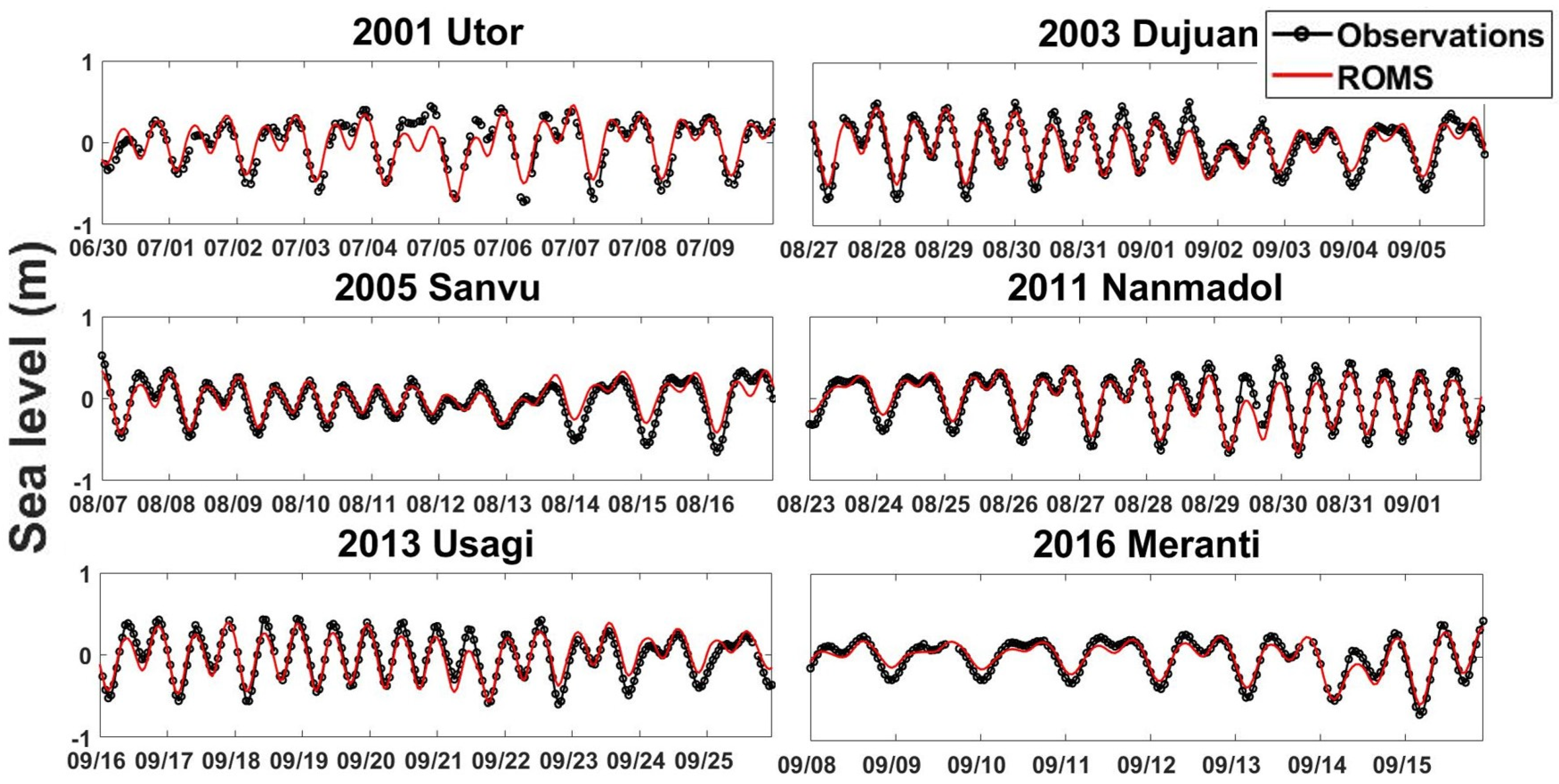
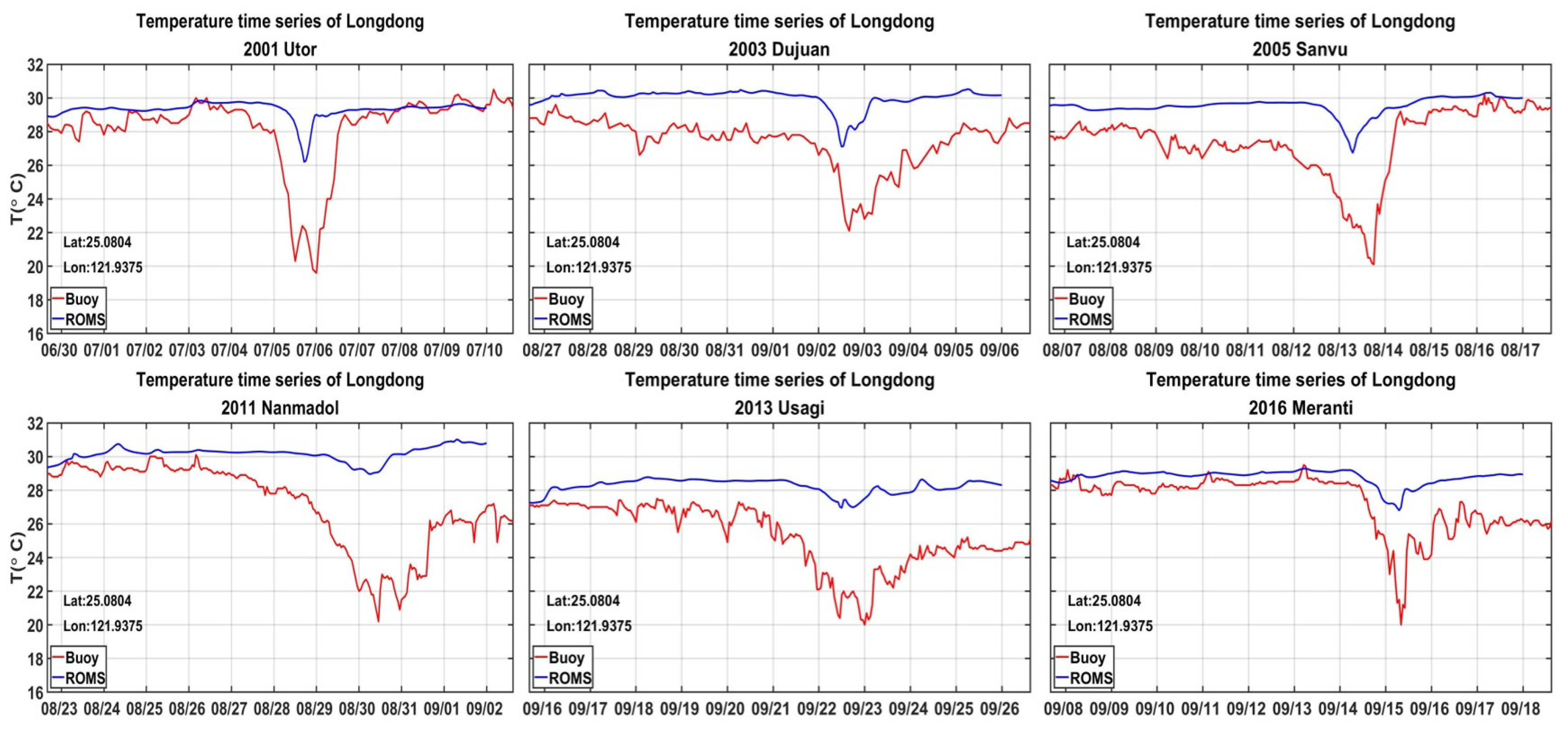
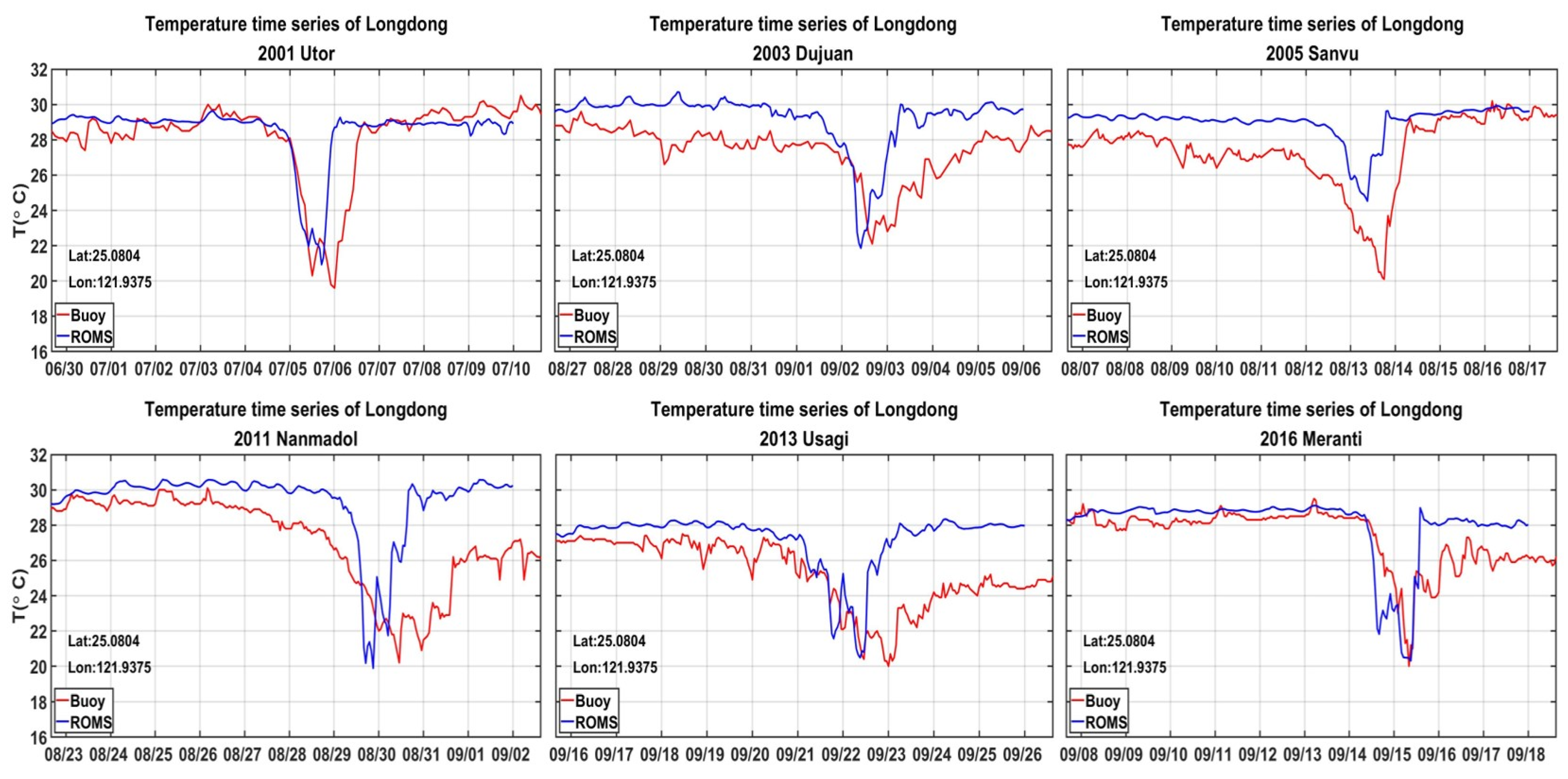
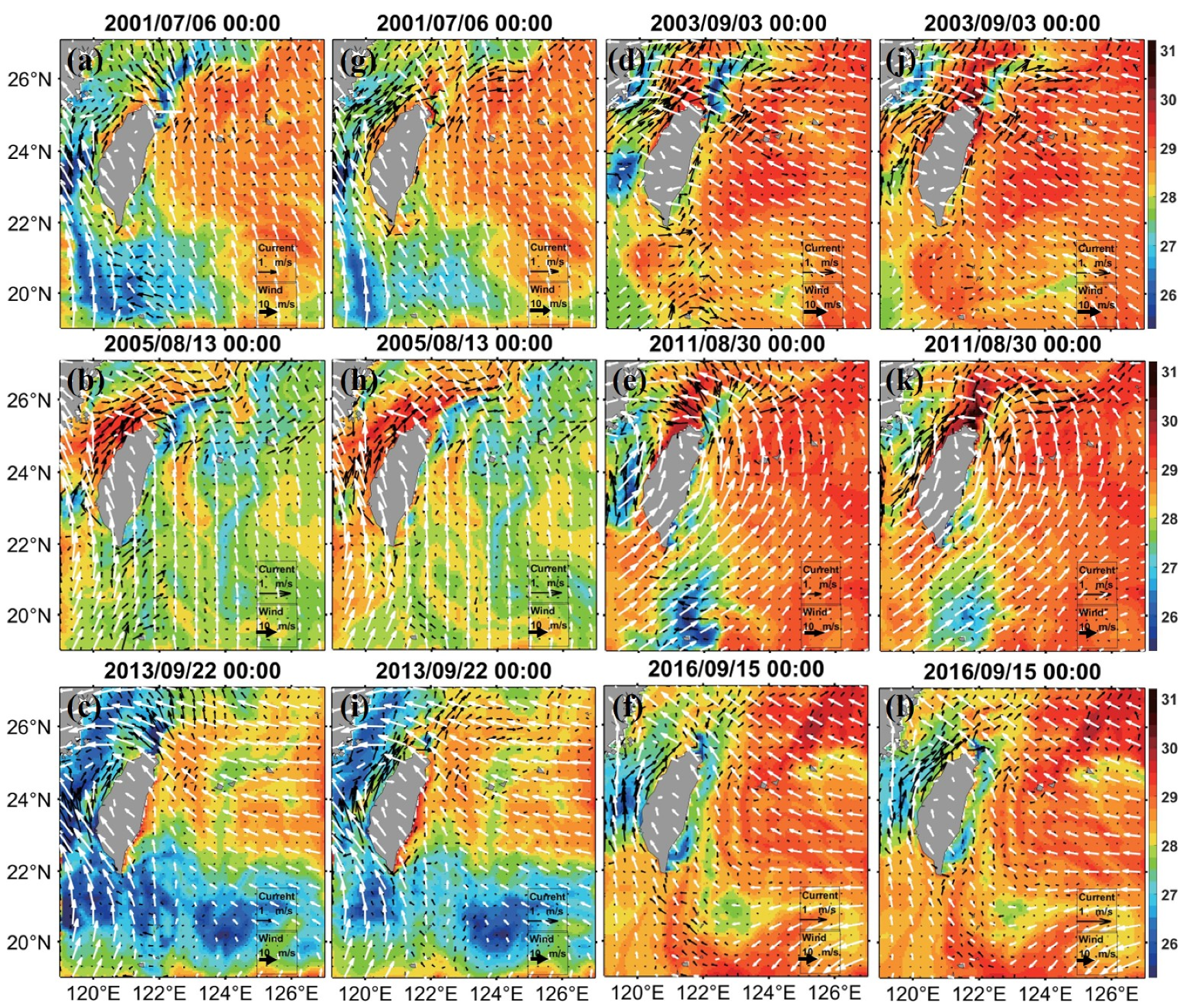


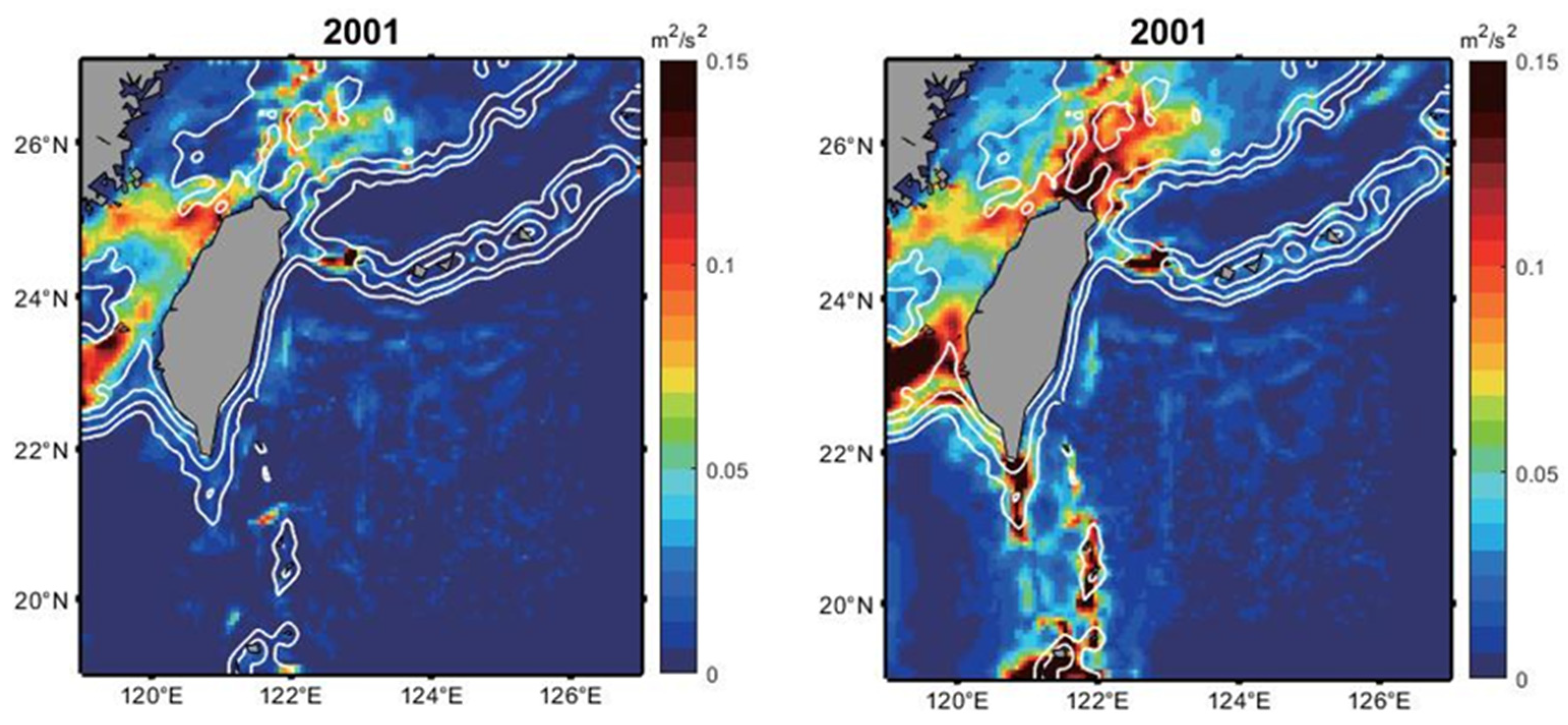
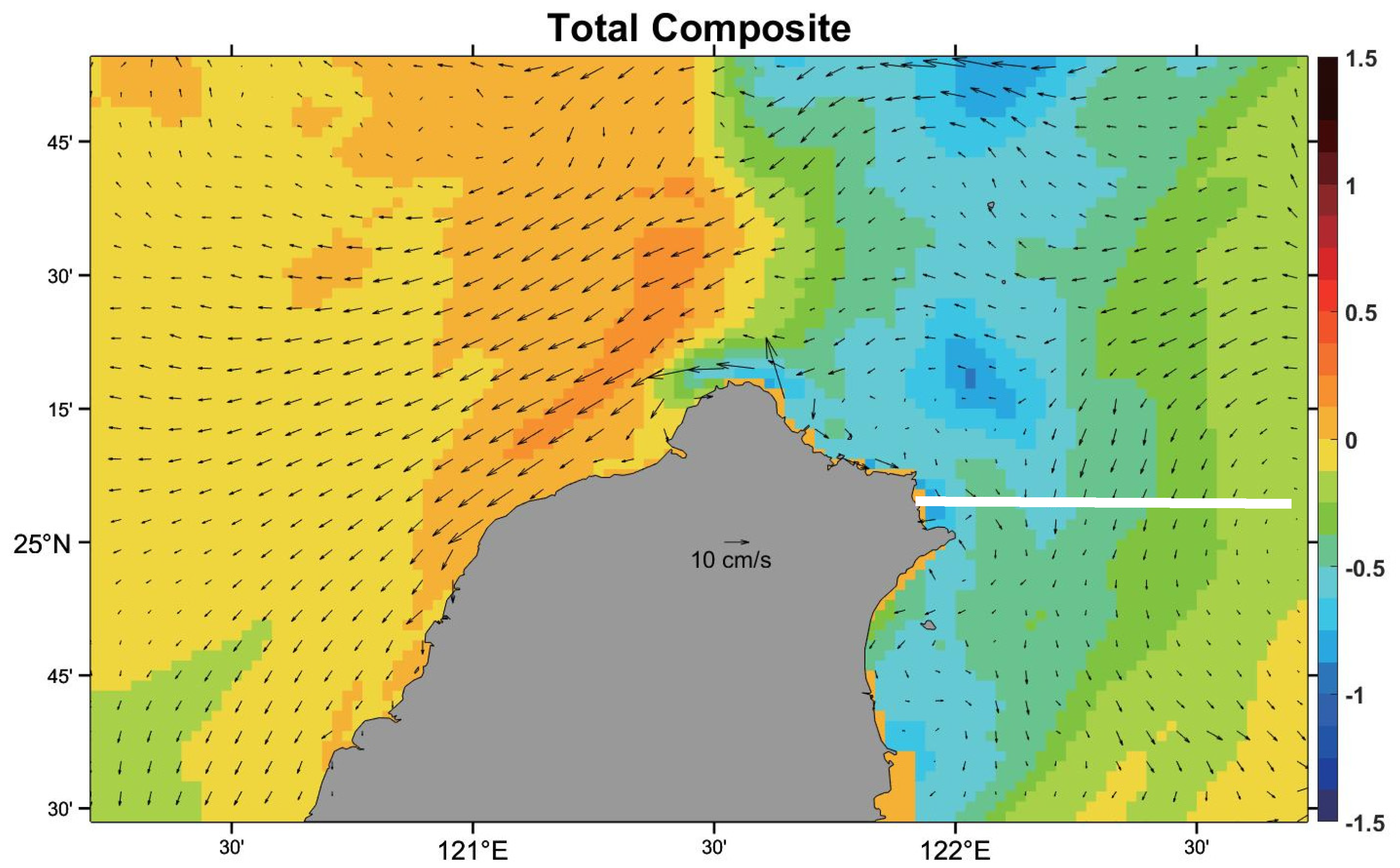
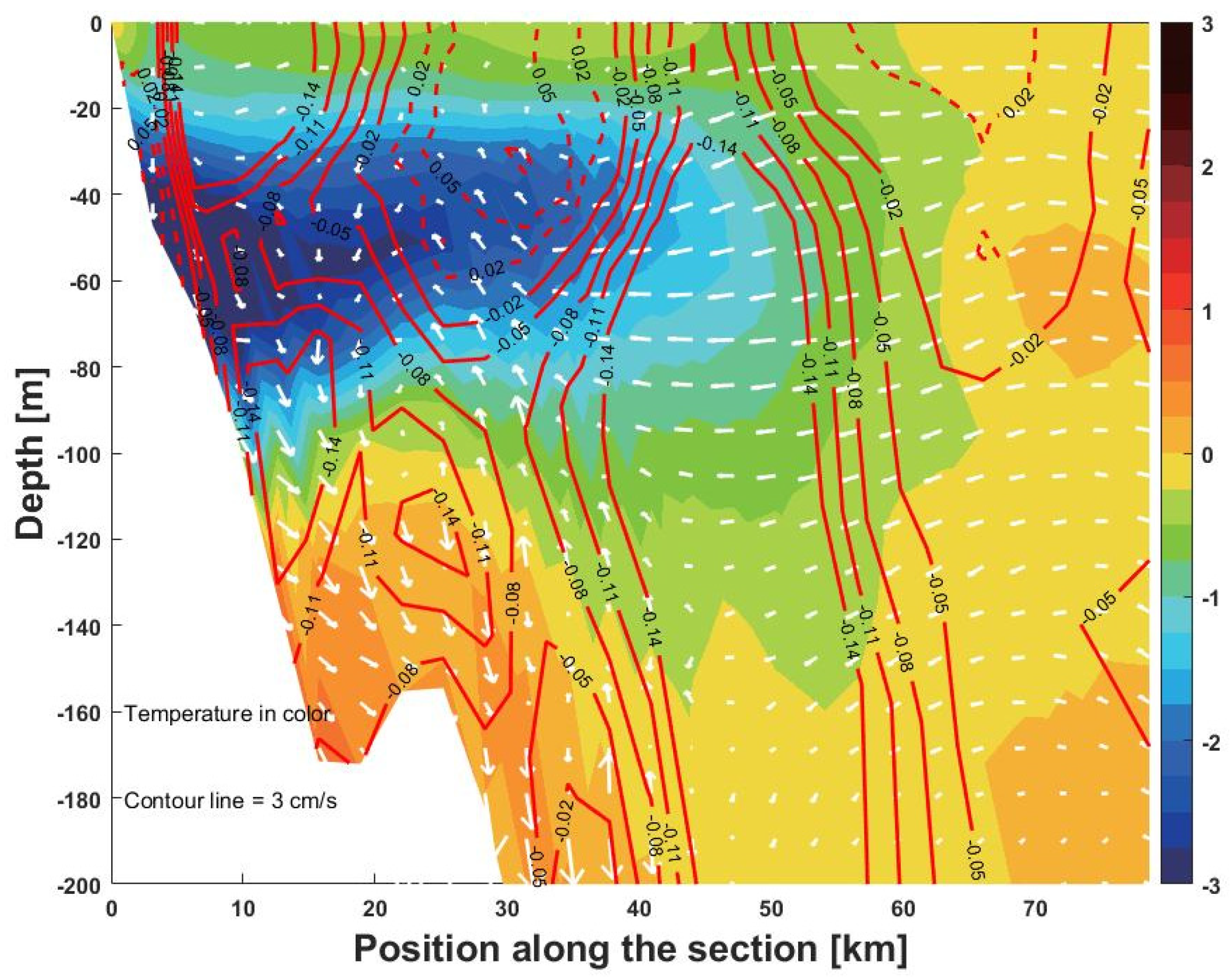
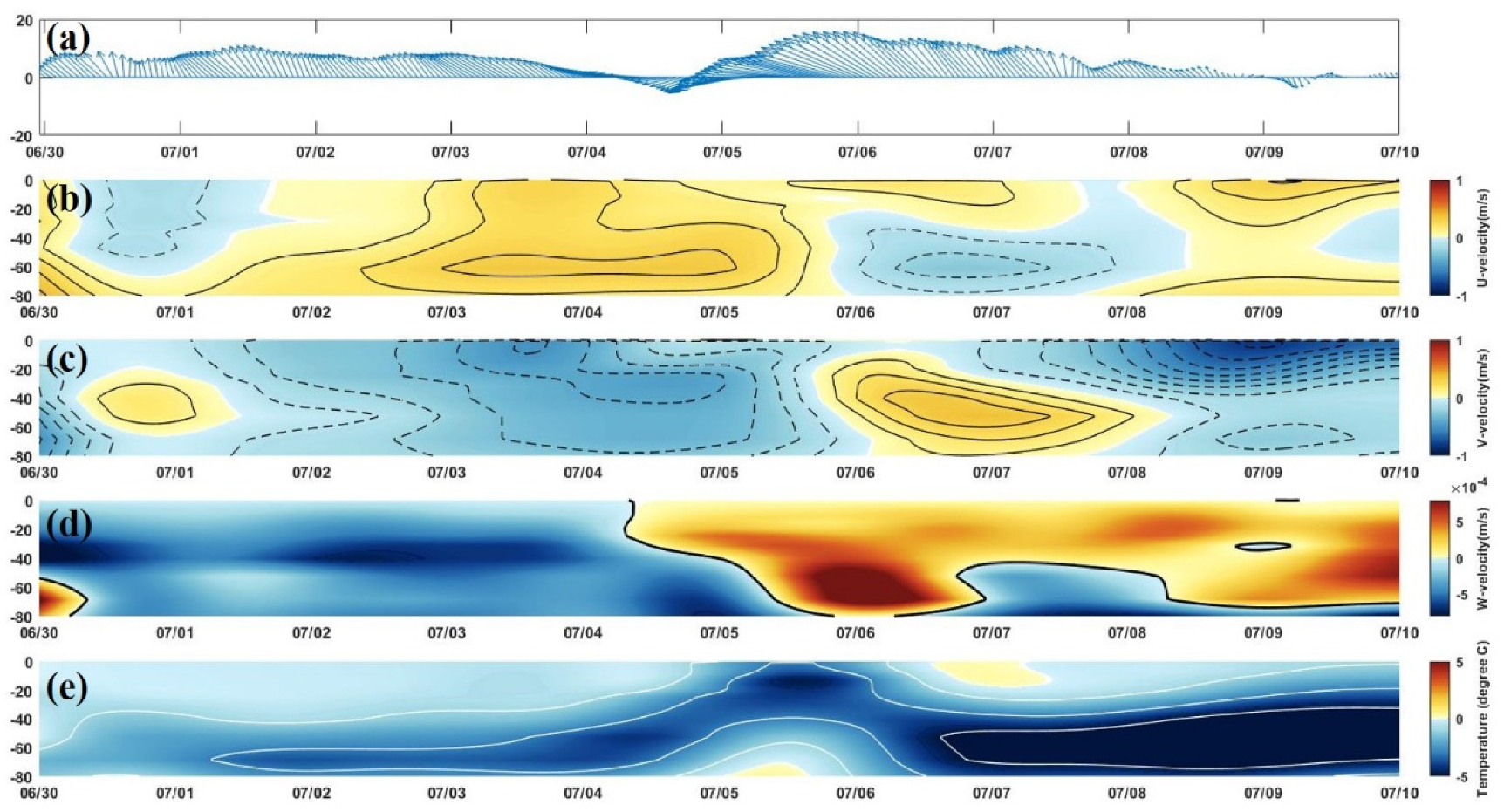
| Cases | Simulation Periods | Initial Date | Ending Date | Intensity Category | Moving Speed (ms−1) | Maximum Sustained Wind (ms−1) | ΔSST |
|---|---|---|---|---|---|---|---|
| Utor | 6/28~7/10 | 2001/7/1 | 2001/7/7 | I | 9.2 | 38 | 9 |
| Dujuan | 8/25~9/6 | 2003/8/27 | 2003/9/3 | IV | 8.3 | 43 | 6 |
| Sanvu | 8/5~8/17 | 2005/8/9 | 2005/8/14 | I | 6.4 | 20 | 7.3 |
| Nanmadol | 8/21~9/2 | 2011/8/21 | 2011/8/31 | V | 2.5 | 35 | 8.9 |
| Usagi | 9/14~9/26 | 2013/9/16 | 2013/9/24 | V | 5.3 | 53 | 6.4 |
| Meranti | 9/6~9/18 | 2016/9/8 | 2016/9/16 | V | 5.6 | 58 | 8.3 |
Publisher’s Note: MDPI stays neutral with regard to jurisdictional claims in published maps and institutional affiliations. |
© 2022 by the authors. Licensee MDPI, Basel, Switzerland. This article is an open access article distributed under the terms and conditions of the Creative Commons Attribution (CC BY) license (https://creativecommons.org/licenses/by/4.0/).
Share and Cite
Zheng, Z.-W.; Chen, Y.-R. Influences of Tidal Effect on Upper Ocean Responses to Typhoon Passages Surrounding Shore Region off Northeast Taiwan. J. Mar. Sci. Eng. 2022, 10, 1419. https://doi.org/10.3390/jmse10101419
Zheng Z-W, Chen Y-R. Influences of Tidal Effect on Upper Ocean Responses to Typhoon Passages Surrounding Shore Region off Northeast Taiwan. Journal of Marine Science and Engineering. 2022; 10(10):1419. https://doi.org/10.3390/jmse10101419
Chicago/Turabian StyleZheng, Zhe-Wen, and Yi-Rui Chen. 2022. "Influences of Tidal Effect on Upper Ocean Responses to Typhoon Passages Surrounding Shore Region off Northeast Taiwan" Journal of Marine Science and Engineering 10, no. 10: 1419. https://doi.org/10.3390/jmse10101419




